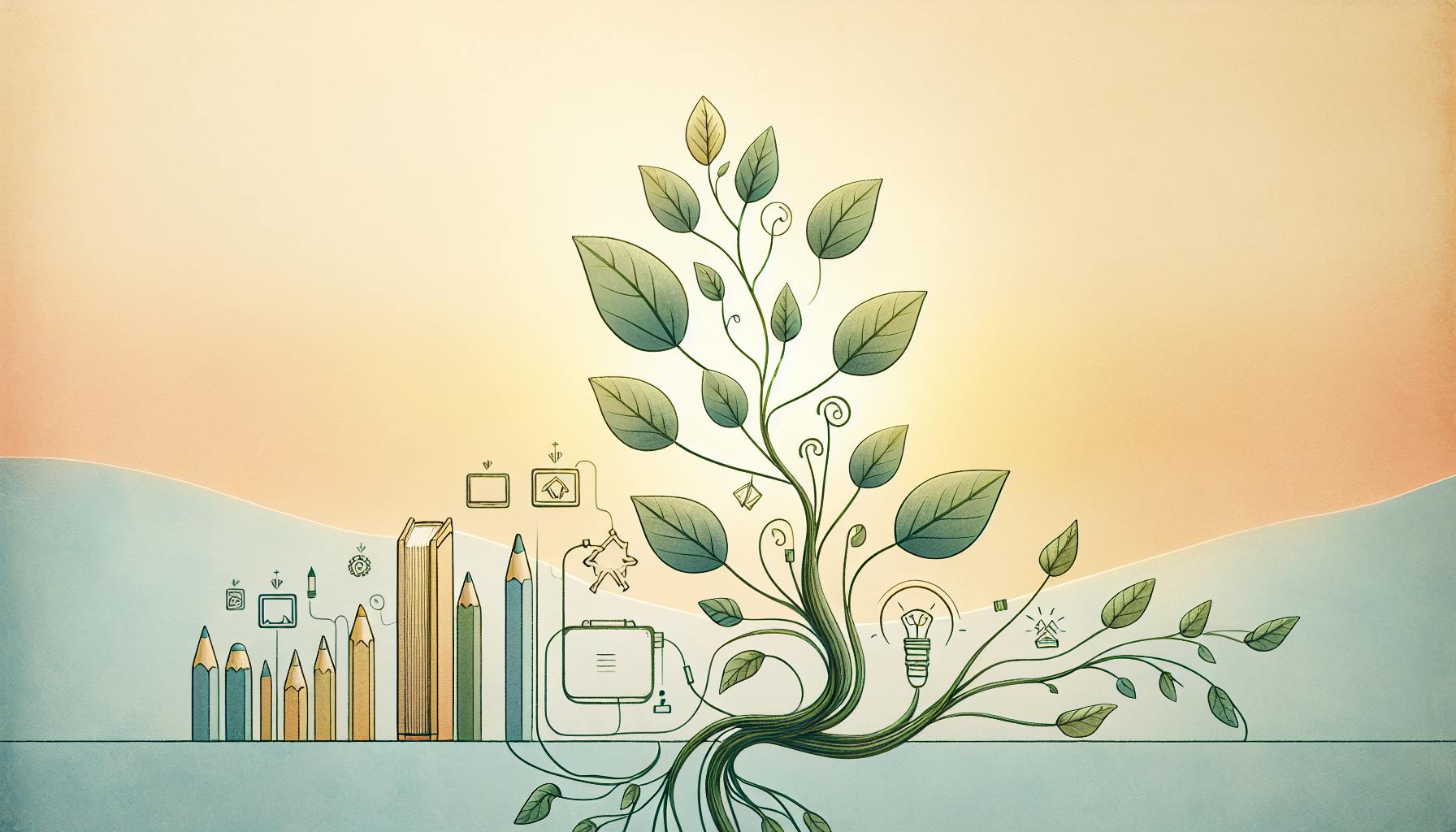Nurturing creativity is vital for student growth, yet obstacles persist.
This article provides innovative strategies to cultivate imagination in the classroom.
We'll explore the benefits of creative thinking, methods to encourage psychological safety and autonomy, hands-on activities like design challenges, assessing creative output, and leveraging technology to unlock inventiveness.
The Importance of Encouraging Creativity in Education
Creativity is a critical skill for students to develop. It allows them to think outside the box, make connections between ideas, and express themselves in innovative ways. As teachers, it's our responsibility to nurture creativity in the classroom.
Defining Creativity in the Classroom
Creativity in the classroom refers to activities, assignments, and projects that allow students to use their imagination. This includes open-ended writing prompts, art projects, building challenges, and opportunities for students to showcase their talents through performance. The goal is to give students a chance to think divergently, take risks, and engage their curiosity.
The Benefits of Creative Thinking
Encouraging creativity has many advantages for students:
- Builds confidence and self-expression
- Allows students to make connections between different subjects and ideas
- Develops critical thinking and problem solving skills
- Prepares students for future careers that require innovation
- Makes learning more engaging, meaningful and fun!
Overcoming Obstacles
Some common obstacles teachers face include:
- Lack of resources and materials
- Focus on standardized testing
- Hesitance to try new teaching methods
- Managing varying student abilities and learning styles
However, creativity can be incorporated through simple changes:
- Allow time for free play and experimentation
- Incorporate open-ended questions and brainstorming
- Provide hands-on building and making opportunities
- Let students showcase talents through art, writing, drama and more
With some effort, we can nurture the next generation of innovative thinkers!
Creating a Psychological Climate Conducive to Creativity
Promoting Psychological Safety
Psychological safety is key to encouraging creativity in the classroom. Students need to feel comfortable taking risks and making mistakes without fear of embarrassment or judgment. Teachers can promote psychological safety by:
- Establishing norms of respect and openness from day one
- Modeling creative thinking and risk taking in their own work
- Praising unique ideas and approaches, even if unsuccessful
- Giving specific, constructive feedback focused on the work rather than the person
- Allowing students room to fail and emphasizing effort over innate talent
An open, accepting environment where students feel safe to think freely and push boundaries is essential for imagination and innovation to thrive.
Innovative Approaches to Autonomy and Choice
Giving students more autonomy over their work has been shown to boost engagement, motivation, and creative thinking. Teachers can provide autonomy and choice in various ways:
- Allow students to select their own topics or methods for assignments
- Create menus of activity options for students to choose from
- Let students form groups or teams based on shared interests
- Provide flexible deadlines for when certain project milestones should be completed
- Encourage students to ask their own research questions and design investigations
By allowing more student control and input, teachers enable learners to tap into their own passions and interests as fuel for imaginative work.
Encouraging Collaboration
Collaborative group work encourages the exchange of diverse perspectives, sparking new connections and ideas. Effective strategies include:
- Think-Pair-Share activities to promote idea exchange
- Jigsaw projects where groups tackle parts of a larger problem
- Peer feedback and review sessions to build on one another's work
- Group brainstorming challenges focused on quantity of ideas
- Interdisciplinary connections across subjects and classes
By valuing all voices and fostering positive interdependence, teachers can create a collaborative climate where creativity thrives.
Elements That Nurture Creativity
Key ingredients for nurturing creative classrooms include:
- Flexibility in use of time, space, and learning modes
- Autonomy for students to direct their own learning
- Openness to new ideas and different perspectives
- Connections across disciplines and to real-world contexts
- Support through coaching and constructive feedback
- Motivation via student passions, interests, and purpose
With the proper balance of these elements, classrooms can become vibrant hubs of imagination, innovation, and ingenuity.
Strategies to Promote Creativity in Secondary Schools
Inquiry-Based Learning
Inquiry-based learning encourages students to explore topics that intrinsically interest them. By allowing students to direct their own learning, teachers give them agency to follow creative paths of discovery. Open-ended questioning teaches critical thinking skills and nurtures innate curiosity. When students take ownership of the learning process, they naturally build creative confidence to imagine innovative solutions.
Design Thinking Challenges
Design thinking introduces the creative process of defining problems, ideating solutions, and iteration. By framing lessons around real-world problems, students utilize empathy, critical thinking, and experimentation to create human-centered solutions. Exposing students to design thinking at an early age builds creative problem-solving skills that prepare them for future careers.
Games and Simulations
Games create active environments for learning that capture student imagination. The interactivity and storytelling immerse students in role playing real-world scenarios. Games allow students to apply knowledge, test hypotheses, and witness the consequences of decisions. This experimentation in safe virtual environments builds skills in judgment, strategizing, and creative thinking.
Learning Corners for Self-Discovery
Learning corners are sections of the classroom dedicated to hands-on exploration of topics. These spaces contain manipulatives, technology, art supplies, and other materials for open-ended discovery. By providing autonomy in self-directed play, learning corners help students organically build creative confidence. Teachers can observe self-discovery patterns and nurture original ideas that emerge.
sbb-itb-bb2be89
Assessment Strategies for Expressing Creativity
Encouraging creativity in the classroom is important, but equally important is having proper assessment strategies in place to evaluate creative outputs and monitor the development of creative thinking skills. Here are some methods teachers can use:
Using Rubrics
- Develop rubrics that clearly define expectations for creativity, including elements like originality, innovation, elaboration, and problem-solving.
- Make sure rubrics align to learning objectives and allow flexibility for students to express creativity in different ways.
- Involve students in rubric creation to promote ownership over criteria.
Student Self-Evaluation
- Have students conduct self-assessments of creative assignments using guided reflection questions.
- Focus questions on the creative process undertaken rather than just the final product.
- Self-evaluation builds metacognition and empowers students to monitor their own creative growth.
Documenting the Creative Process
- Collect early brainstorms, drafts, sketches, and plans to reveal the stages of development in creative work.
- Compare initial concepts to final products to evaluate refinement of ideas over time.
- Keep organized portfolios of process documentation so students can make connections between various creative endeavors over a term or school year.
Thoughtfully designed assessment strategies provide critical insight into both the tangible and intangible aspects of fostering creativity in the classroom.
Leveraging Technology to Unlock Creativity
Technology can be a powerful tool for nurturing creativity in the classroom. Here are some ways teachers can leverage digital tools to amplify creative expression and problem-solving:
Multimedia Production
Design software, video editing programs, and image manipulation apps give students the means to bring their ideas to life. As they craft original animations, films, illustrations, and more, they learn technical skills while exercising their ingenuity. Useful programs include Adobe Creative Cloud, Apple iMovie, Canva, and Blender.
Coding and Computational Thinking
Coding teaches the logical thinking and structured problem-solving that underpins creative solutions. As students build programs, games, and apps, they gain computational skills while exploring self-expression. Great coding tools include Scratch, Alice, JavaScript, and Python.
Simulations and Virtual Environments
Immersive digital worlds let imagination run free. Students can construct simulated ecosystems, societies, and more to experiment with complex systems. Engaging platforms include Minecraft, Roblox, VR headsets, and open-world games.
Guiding students as they use technology to prototype and share ideas fosters an innovative mindset. With scaffolding and encouragement, digital tools can unlock creativity across the curriculum.
Conclusion: Synthesizing Innovative Approaches and Strategies
Encouraging creativity in the classroom is vital for nurturing students' imaginations and self-expression. As discussed, there are several key strategies teachers can employ:
Essential Elements for Cultivating Creativity
- Provide an open, psychologically safe environment where students feel comfortable taking risks and making mistakes. This builds confidence to imagine freely.
- Incorporate open-ended activities that allow for multiple solutions rather than one right answer. This gives space for creative thinking.
- Allow time for self-directed exploration and discovery. Letting students follow their own interests fuels intrinsic motivation and imagination.
Top Teaching Techniques
- Set creativity challenges, such as inventing something new or combining ideas in innovative ways. This stretches imaginations.
- Use brainstorming sessions to generate many ideas without judgement before evaluating. This encourages fluency of thought.
- Ask lots of imaginative "what if" questions to spur visionary thinking.
Final Thoughts on Encouraging Student Imagination
Cultivating creativity requires an environment where students feel psychologically safe to imagine, invent, and take risks. Open-ended challenges, self-directed discovery, and brainstorming are key strategies. With the right climate, students' creativity can flourish.


